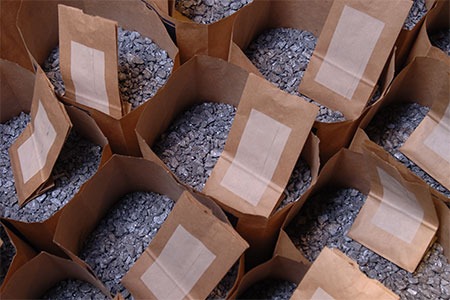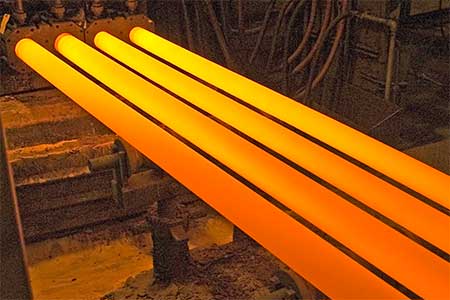Dura-Bar Advantages
Overview
Since 1961, the Dura-Bar continuous iron casting process has provided unparalleled value for those needing an efficient metal for production of their machined component parts. Dura-Bar continuous cast iron offers numerous physical and structural advantages over steel, castings and aluminum because of the unique manufacturing methods. Our ability to engineer a combination of various graphite and matrix structures (ferritic versus pearlitic) results in a variety of grades with a full range of properties. That means Dura-Bar can be tailored in a way that best meets your needs. Plus, the Dura-Bar process enables the material's microstructure to be free from shrinkage, gas holes, sand and other tool-wearing inclusions.

So how is all this beneficial to you? Dura-Bar can lower overall part costs and improve part performance. Making parts run quieter, increasing tool life, gaining throughput and saving money are just a few of the many benefits realized by using Dura-Bar.
Browse common Dura-Bar material advantages below, or contact us to discuss your part and how you can benefit.

-
 Corrosion Resistance
Corrosion Resistance
Corrosion resistance is not a specific property of a metal but a characteristic that depends on the conditions of exposure and the quality of performance that is required. All Dura-Bar irons have two constituents in their microstructure, graphite and the matrix structure. Graphite will withstand a wide variety of chemical and atmospheric conditions and the matrix structure will behave similar to non-alloyed steel under the same conditions.
Dura-Bar Ni-Resist, having an austenitic matrix, is the most corrosion resistant grade, although even standard grades of Dura-Bar may be suitable depending on the environment. Selection of the proper grade depends on the application. Each case should be reviewed independently.
-
 Fatigue Strength
Fatigue Strength
Fatigue strength is primarily influenced by the graphite size and shape and will also be affected by the matrix structure. The Dura-Bar continuous casting process and strict metallurgical controls result in a uniformly dense, fine-grained microstructure essentially free of porosity, sand and other inclusions that can affect the endurance ratio and severely lower fatigue life. Dura-Bar has optimal strength in tension, compression and fatigue versus castings. Ductile irons having nodular graphite will have the highest endurance ratio, and gray irons with coarse flake graphite will have the lowest.
-
 Hardness
Hardness
Hardness measures the material characteristics of strength and wear resistance and is also an indicator of machinability. Material hardness of cast iron is usually measured by Brinell Hardness Testing (BHN). This measure is easily converted to other hardness values for comparisons. It is important to use hardness as a measure of strength, wear and machinability, but only within a particular grade. Different grades of iron or steel with the same hardness values may not be comparable in strength, wear and machinability. The softest grade of Dura-Bar has a hardness of 131 BHN. The maximum hardness value is 329 BHN.
-
 Heat Treat Response
Heat Treat Response
Dura-Bar cast iron has excellent response to heat treating. An achievable matrix hardness of 60 Rc and an average hardness of 50 Rc are possible. Severity of quench rate must be controlled to reduce the possibility of cracking. Stress relieving may be necessary depending on the nature of the heat-treat.
-
 Inventory
Inventory
Dura-Bar understands the power of logistics. We support your inventory needs with an extensive inventory of over 500 in-stock sizes. Dura-Bar product is further dispersed through a network of distributors with over 100 locations in the United States, Canada, Mexico and China. These distributors all maintain a local inventory of Dura-Bar and provide a number of additional processing and inventory services. All this means shorter lead times and faster delivery to your dock.
The Dura-Bar continuous casting process can supply product in near-net shapes, eliminating the need for expensive patterns or molds. This can allow for the elimination or reduction of machining versus castings and traditional bar stock.
The process, combined with the extensive inventory, optimizes time and cost efficiencies. To the customer, this translates into faster delivery and shorter time-to-market.
-
Machinability
The Dura-Bar continuous casting process and the product's graphite properties result in faster machining (as much as 50%) and less scrap over carbon and alloy steels. The superior Machinability is possible due to the graphite in Dura-Bar iron giving it natural chip breaking abilities and resulting in precision machining at optimal speeds. The material being removed will either come off in long stringers or small chips, commonly known as free machining. Steel "free machining" is possible only by adding elements, such as lead, resulting in particles being present in the materials.
The matrix structure is the most significant contributing factor that effects ease of cutting and tool life. Dura-Bar 65-45-12 ductile iron has the highest ferrite percentage in the ductile grades and is most easily machined. The G1 and G1A gray iron grades contain ferrite, making them easier to machine than G2 or G2A fully pearlitic grades.
Dimensional stability depends on the machining conditions and the amount of residual stresses in the as-cast bar. Most applications do not require stress relieving. Occasionally it is necessary when extremely close tolerances are required in the machined part. Material grades, by themselves, do not adversely affect the ability to hold tight dimensional tolerances, although more residual stresses result in a part when machining harder materials.
Read more about the advantages of Dura-Bar's superior machinability or download our Machining Guide for wear rate comparisons, recommendations of speeds and feed and more.
-
 Reduced Scrap
Reduced Scrap
The metallurgical properties of Dura-Bar mean better machinability resulting in little or no scrap. The Dura-Bar continuous casting process and rigorous on-line and laboratory testing procedures detect any imperfections before shipment to the customer. In contrast to normal scrap rates of 10% to 40% with static iron castings, users of continuous cast bars can virtually eliminate scrap. In fact, Dura-Bar is the only iron bar product with a Zero Defect Guarantee.
-
 Surface Finish
Surface Finish
Dura-Bar's fine-grained microstructure allows excellent surface finishes after machining. Surface finishes to 10 RMS can be achieved without secondary operations such as grinding and honing. Machined finishes of 32 RMS are typical.
Optimal surface finishes are achieved with fine flake size. Coarse graphite flakes can lead to tearing of the material during machining resulting in a rougher finish. Slight modifications in tooling and machining conditions can minimize this condition.
The need for deburring is virtually eliminated. Parts are free from dross slag and other tool wearing inclusions. The superior finish, free from sand inclusions, results in longer tool life.
-
 Thermal Conductivity
Thermal Conductivity
Dura-Bar irons have excellent thermal conductivity due to the presence of graphite. This is an advantage in applications such as permanent molds and glass molds where heat is cycled through a part. Coarse flake graphite in a ferritic matrix has a thermal conductivity value of approximately 2 times that of low carbon steel.
-
 Vibration Damping
Vibration Damping
The graphite composition in Dura-Bar gives it a much higher damping capacity than low carbon steel, cushioning vibrations as they are transmitted through a part. This ability to dampen vibrations results in a quieter product than is possible with a steel product manufactured to the same dimensional tolerances and with similar surface finishes. Dura-Bar gray iron has at least 10 times the damping capacity of low carbon steel and Dura-Bar ductile iron has three times the capacity.
When three "chimes", same size pieces, of gray iron, ductile iron and steel are each struck, the vibration and ringing sound resonate for different lengths of time. Gray iron, which may even be difficult to hear, stops immediately; ductile iron rings for a short time while steel resonates for an extended period of time.
Click on the links below to hear the sound of each metal being struck
-
 Wear Resistance
Wear Resistance
Dura-Bar continuous cast iron weighs 10% less than steel resulting in substantial savings in material, transportation and delivery costs to the manufacturer. This can also be especially important when meeting requirements in applications where weight is a consideration.
To learn more, see our article on density. The weight difference between Dura-Bar and steel can mean cost savings in shipping, as well as weight reduction of the part being converted from steel to Dura-Bar.
-
 Weight Reduction
Weight Reduction
Dura-Bar continuous cast iron weighs 10% less than steel resulting in substantial savings in material, transportation and delivery costs to the manufacturer. This can also be especially important when meeting requirements in applications where weight is a consideration.
To learn more, see our article on density. The weight difference between Dura-Bar and steel can mean cost savings in shipping, as well as weight reduction of the part being converted from steel to Dura-Bar.